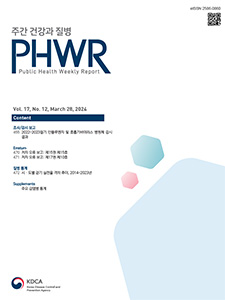Current Issue
Vol.17 No.12, March 28, 2024
-
Surveillance Reports 2024-03-28
 1
1
 1113
1113
 210
210
Korea 2022–2023 Influenza and Respiratory Viruses Laboratory Surveillance Report
SangHee Woo, Nam-Joo Lee, Jaehee Lee, Jee Eun Rhee, Eun-Jin Kim
Public Health Weekly Report 2024; 17(12): 455-469 https://doi.org/10.56786/PHWR.2024.17.12.1 Abstract
AbstractDuring the 2022–2023 season, spanning 36 weeks in 2022 and 35 weeks in 2023, we performed real-time reverse transcription polymerase chain reaction tests on 15,009 respiratory specimens to analyze the causative pathogens and viral characteristics. Of these, 1,341 cases (8.9%) tested positive for influenza. Among positive cases, 1,085 cases (80.9%) were identified as A(H3N2), 211 (15.7%) as A(H1N1)pdm09, and 45 (3.4%) as type B. Genotype analysis confirmed similarity to vaccine strains. Furthermore, antigens from isolated influenza viruses exhibited effective neutralizing activity against vaccine strains and lacked resistance to oseltamivir, zanamivir, and peramivir treatments. Regarding other respiratory viruses, Rhinovirus was the most prevalent, detected in 1,978 cases (13.2%), followed by adenovirus (1,564 cases, 10.4%), metapneumovirus (1,456 cases, 9.7%), parainfluenza virus (1,430 cases, 9.5%), respiratory syncytial virus (1,139 cases, 7.6%), bocavirus (794 cases, 5.3%), and human coronavirus (742 cases, 4.9%). Following the relaxation of coronavirus disease 2019 control measurements, we observed a seasonal increase in respiratory viral diseases, highlighting the importance of national respiratory viral surveillance. Our department remains committed to closely monitoring causative pathogens and analyzing influenza virus trends and characteristics.
-
Erratum 2024-03-28
 0
0
 531
531
 231
231
Erratum : Volume 15. No 15.
Public Health Weekly Report 2024; 17(12): 470-470 https://doi.org/10.56786/PHWR.2024.17.12.2 -
Erratum 2024-03-28
 0
0
 397
397
 160
160
Erratum : Volume 17. No 10.
Public Health Weekly Report 2024; 17(12): 471-471 https://doi.org/10.56786/PHWR.2024.17.12.3 -
QuickStats 2024-03-28
 0
0
 307
307
 137
137
Trends in the Prevalence Gap of Walking between Cities or Provinces, During 2014–2023
Public Health Weekly Report 2024; 17(12): 472-473 https://doi.org/10.56786/PHWR.2024.17.12.4

pp. 1~2097
Most Keyword
?
What is Most Keyword?
- It is the most frequently used keyword in articles in this journal for the past two years.
Most Read
-
Waterborne and Foodborne Disease Outbreaks in the Republic of Korea, 2023
Myung-Jae Hwang, So Yeon Park, Hyungjun Kim, Se Jeong Yang, Sungchan Yang, Jin Seon Yang
Public Health Weekly Report 2025;18: 17-32 https://doi.org/10.56786/PHWR.2025.18.1.2 -
Implementation Plan for the Coronavirus Disease 2019 Vaccination for the 2024–2025 Season: Recommendations of the 6th Expert Committee on Immunization Practices
Hyewook Hwang, Wookeon Lee, Seohyeon Ahn, Young-Sook Choi, Seunghyun Lewis Kwon, Dongwoo Lee, Eun Hwa Choi, SokGoo Lee
Public Health Weekly Report 2025;18: 90-102 https://doi.org/10.56786/PHWR.2025.18.2.3
Editorial Office
+82-43-719-7569





 Full Text
Full Text Cite
Cite


